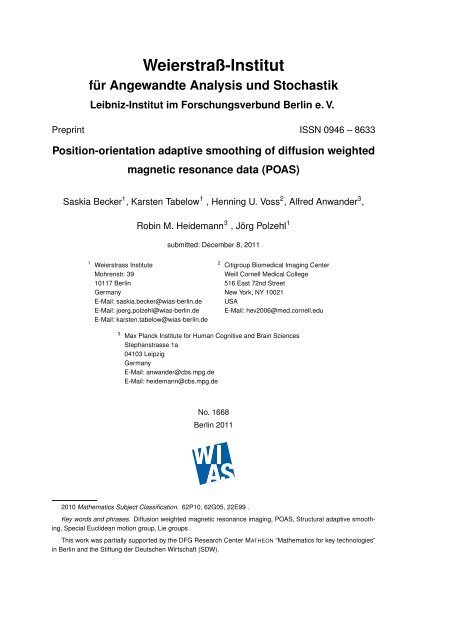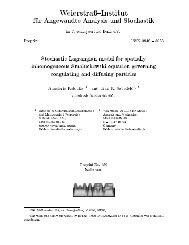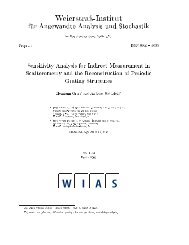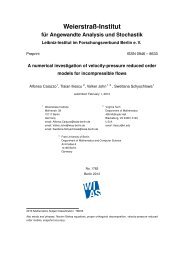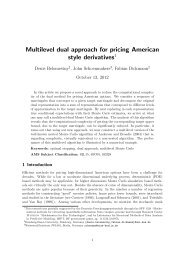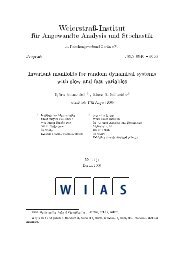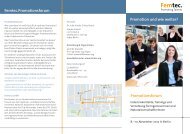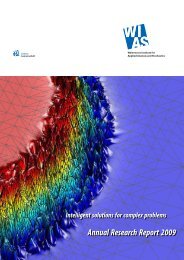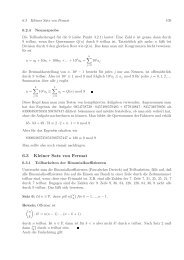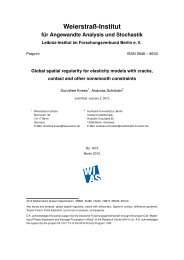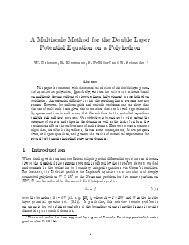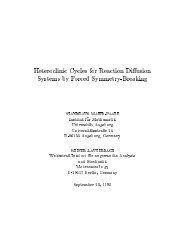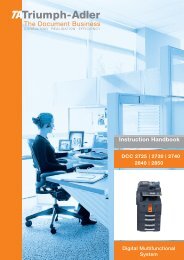PDF (5143 kByte) - WIAS
PDF (5143 kByte) - WIAS
PDF (5143 kByte) - WIAS
Create successful ePaper yourself
Turn your PDF publications into a flip-book with our unique Google optimized e-Paper software.
Weierstraß-Institut<br />
für Angewandte Analysis und Stochastik<br />
Leibniz-Institut im Forschungsverbund Berlin e. V.<br />
Preprint ISSN 0946 – 8633<br />
Position-orientation adaptive smoothing of diffusion weighted<br />
magnetic resonance data (POAS)<br />
Saskia Becker 1 , Karsten Tabelow , 1 , Henning U. Voss 2 , Alfred Anwander 3 ,<br />
Robin M. Heidemann , 3 , 1<br />
, Jörg Polzehl<br />
1<br />
Weierstrass Institute<br />
Mohrenstr. 39<br />
10117 Berlin<br />
Germany<br />
E-Mail: saskia.becker@wias-berlin.de<br />
E-Mail: joerg.polzehl@wias-berlin.de<br />
E-Mail: karsten.tabelow@wias-berlin.de<br />
submitted: December 8, 2011<br />
2<br />
Citigroup Biomedical Imaging Center<br />
Weill Cornell Medical College<br />
516 East 72nd Street<br />
New York, NY 10021<br />
USA<br />
E-Mail: hev2006@med.cornell.edu<br />
3 Max Planck Institute for Human Cognitive and Brain Sciences<br />
Stephanstrasse 1a<br />
04103 Leipzig<br />
Germany<br />
E-Mail: anwander@cbs.mpg.de<br />
E-Mail: heidemann@cbs.mpg.de<br />
No. 1668<br />
Berlin 2011<br />
2010 Mathematics Subject Classification. 62P10, 62G05, 22E99 .<br />
Key words and phrases. Diffusion weighted magnetic resonance imaging, POAS, Structural adaptive smoothing,<br />
Special Euclidean motion group, Lie groups .<br />
This work was partially supported by the DFG Research Center MATHEON “Mathematics for key technologies”<br />
in Berlin and the Stiftung der Deutschen Wirtschaft (SDW).
Edited by<br />
Weierstraß-Institut für Angewandte Analysis und Stochastik (<strong>WIAS</strong>)<br />
Leibniz-Institut im Forschungsverbund Berlin e. V.<br />
Mohrenstraße 39<br />
10117 Berlin<br />
Germany<br />
Fax: +49 30 2044975<br />
E-Mail: preprint@wias-berlin.de<br />
World Wide Web: http://www.wias-berlin.de/
ABSTRACT. We introduce an algorithm for diffusion weighted magnetic resonance imaging data<br />
enhancement based on structural adaptive smoothing in both space and diffusion direction. The<br />
method, called POAS, does not refer to a specific model for the data, like the diffusion tensor or<br />
higher order models. It works by embedding the measurement space into a space with defined<br />
metric and group operations, in this case the Lie group of three-dimensional Euclidean motion<br />
SE(3). Subsequently, pairwise comparisons of the values of the diffusion weighted signal are<br />
used for adaptation. The position-orientation adaptive smoothing preserves the edges of the<br />
observed fine and anisotropic structures. The POAS-algorithm is designed to reduce noise<br />
directly in the diffusion weighted images and consequently also to reduce bias and variability of<br />
quantities derived from the data for specific models. We evaluate the algorithm on simulated and<br />
experimental data and demonstrate that it can be used to reduce the number of applied diffusion<br />
gradients and hence acquisition time while achieving similar quality of data, or to improve the<br />
quality of data acquired in a clinically feasible scan time setting.<br />
1. INTRODUCTION<br />
Diffusion weighted magnetic resonance imaging (dMRI) has evolved into a versatile tool for<br />
in-vivo examination of micro-structure in the human brain [Le Bihan, 2003], spinal cord [Clark<br />
et al., 1999], or muscle tissue [Sinha et al., 2006]. The data is measured using the pulsed<br />
gradient spin echo sequence [PGSE, Stejskal and Tanner, 1965] through application of diffusion<br />
magnetic field gradients in different directions. The technique is based on the fact that nuclear<br />
magnetic resonance is sensitive to the diffusion of molecules, usually water. Each applied<br />
magnetic field gradient yields a diffusion weighted image which, together with the non-diffusion<br />
weighted image, reveals information about the average displacement of hydrogen protons in the<br />
corresponding direction at each voxel.<br />
In the past two decades the development of diffusion tensor imaging (DTI) made dMRI more feasible<br />
for a wider range of clinical and neuroscience applications (see Mori [2007] and Johansen-<br />
Berg and Behrens [2009] for an introduction). In order to characterize the data by a diffusion<br />
tensor at least six gradient directions have to be measured. However, the diffusion tensor model<br />
provides only an approximation for the more realistic case of inhomogeneous and restricted diffusion,<br />
spurring recent interest in models beyond DTI [Assemlal et al., 2011]. Most of the methods<br />
developed to overcome the limitations of DTI require a larger number of diffusion weighted<br />
gradients to be applied during measurement and hence a longer acquisition time.<br />
Like all other imaging modalities dMRI suffers from significant noise which may render subsequent<br />
analysis or medical decisions more difficult. For DTI it has been shown that noise induces<br />
a systematically biased assessment of features, like the fractional anisotropy (FA), which are<br />
based on the ordered eigenvalues of the estimated diffusion tensor [Pierpaoli and Basser, 1996,<br />
Basser and Pajevic, 2000]. Jones and Basser [2004] showed that noise creates artifacts for<br />
dMRI data in general. Last but not least, increasing the spatial resolution inherently decreases<br />
the signal-to-noise ratio (SNR). Attempts to achieve higher image resolution collide with the<br />
deterioration of the acquired images. Noise reduction is therefore essential.<br />
Besides simple isotropic smoothing, which potentially blurs fine structures, more sophisticated<br />
methods for noise reduction have been developed, such as the Perona-Malik filter [Perona<br />
and Malik, 1990, Parker et al., 2000], non-linear diffusion approaches [Weickert, 1998, Ding<br />
et al., 2005, Duits and Franken, 2011], or the Propagation-Separation approach [Polzehl and<br />
Spokoiny, 2006, Tabelow et al., 2008]. Other attempts combine wavelet filtering with subsequent<br />
1
2<br />
non-linear diffusion [Lohmann et al., 2010], or perform smoothing in tensor space [Fletcher and<br />
Joshi, 2007, Fillard et al., 2007]. It is generally preferable to smooth the diffusion weighted images<br />
directly rather than model dependent derived quantities. First, such an approach avoids<br />
the bias for model dependent estimates induced by the noise. For DTI it also reduces the probability<br />
of estimating a degenerated tensor. Second, if the method does not refer to a specific<br />
model, data can be subsequently analyzed with any model.<br />
In this paper we will develop a position-orientation adaptive smoothing algorithm (POAS) for<br />
dMRI, that does not rely on a specific model like the diffusion tensor or higher order models. This<br />
is a significant development from our recent structural adaptive smoothing method for DTI [Tabelow<br />
et al., 2008], which was based on modeling of the dMRI data by the diffusion tensor model.<br />
Furthermore, we will outline, how the specific geometry of the space in which dMRI is typically<br />
measured can be used in order to benefit from the whole information of the data, in position and<br />
orientation. Here, we will use results from a recent contribution by Duits and Franken [2011],<br />
who developed a smoothing algorithm based on the non-linear diffusion equation. Our method<br />
is based on the Propagation-Separation approach [Polzehl and Spokoiny, 2006] and hence, unlike<br />
other smoothing methods, includes an intrinsic stopping criterion. The new method POAS<br />
is able to reduce noise without blurring the edges of the structures observed with dMRI. We will<br />
show through extensive simulation and experimental data, how the position-orientation adaptive<br />
smoothing algorithm significantly improves the quality of the diffusion weighted data prior to<br />
estimation of diffusion tensors or higher order models.<br />
2. THEORY<br />
In the first part of this section we want to discuss the geometry of the space in which dMRI is<br />
typically measured. We introduce a discrepancy function on this space following the approach<br />
in Duits and Franken [2011]. Then, we present our new position-orientation adaptive smoothing<br />
method (POAS) including further comments on the choice of parameter values.<br />
2.1. The underlying geometry. In diffusion weighted imaging data is typically acquired on a<br />
regular grid of voxels for varying directions of the diffusion magnetic field gradient at a fixed<br />
b-value 1 . The latter can be described by a unit vector in S 2 , where S 2 := {u ∈ R 3 : u = 1}<br />
denotes the 2-sphere. Hence, dMRI data form a function S : R 3 × S 2 → R.<br />
In this section, we want to introduce a discrepancy function on R 3 × S 2 . On that space there<br />
exist neither a metric nor a group operation. So, following the approach in Duits and Franken<br />
[2011] we embed the space R 3 ×S 2 into the Lie group SE(3) := R 3 ⋊SO(3) of 3 dimensional<br />
Euclidean motion, where SO(3) denotes the 3 dimensional rotation group and ⋊ the semidirect<br />
product.<br />
First, we remind of the concept of left coset spaces. The set<br />
[g] H := g ·G H := {g ·G h : h ∈ H}, g ∈ G,<br />
is called left coset of the group G w.r.t. the subgroup H. The space of all left cosets G/H forms<br />
a partition of G. Considering the parametrization of S 2 and SO(3) as given in Appendix A.1,<br />
we note that each element u(β,γ) of S 2 depends on two angles β and γ, while the elements<br />
1 Acquisition schemes that require multiple q-shells or varying b-value are not considered in this paper. The<br />
methods proposed here may be applied separately for each b-value.
R(α,β,γ) of SO(3) additionally depend on a third angle α which describes the rotation around<br />
the z-axis. More precisely, for any u ∈ S2 there is a matrix R ∈ SO(3) such that Ruez = u.<br />
This observation allows us to uniquely identify S2 with the left coset space SO(3)/stab(ez) of<br />
SO(3), which is defined as follows:<br />
SO(3)/stab(ez) := <br />
R(α,β,γ) : R(α,β,γ) ∈ SO(3) ,<br />
where stab(ez) ⊆ SO(3) denotes the group of rotations around the z-axis and<br />
<br />
R(α,β,γ) := R(α,β,γ) stab(ez) := {R(α ′ ,β,γ) : α ′ ∈ [0, 2π)}.<br />
In other words, we construct equivalence classes [.] by identifying all elements of SO(3) where<br />
the angles β and γ coincide while the angle α is ignored. Then, for any u(β,γ) ∈ S2 it holds<br />
u(β,γ) ≡ <br />
R(α,β,γ) ∈ SO(3)/stab(ez), ∀ α ∈ [0, 2π).<br />
Finally, it follows R 3 × S 2 ∼ = SE(3)/({0} ⋊ stab(ez)) since R 3 /{0} = R 3 . In the following we<br />
will write R 3 ⋊ S 2 instead of R 3 × S 2 referring to the group structure which has been introduced<br />
on R 3 × S 2 by the embedding into SE(3).<br />
The Riemannian 1-norm relates to the length of the geodesic, i.e. the shortest way within SE(3),<br />
from the identity element e to g. Analogous to the well-known L p -spaces, where L 2 is often<br />
preferred because of its technical advantages, we consider the Riemannian 2-norm instead of<br />
the Riemannian 1-norm. It can be interpreted as L 2 -analog. In Duits [2005] the Riemannian<br />
2-norm has been suggested as modulus function on SE(2). On SE(3) the Riemannian 2-norm<br />
of g := (v, R(α,β,γ)) ∈ SE(3) with v := (x, y, z) T can be approximated locally by<br />
(1) gR ≈<br />
where the coordinates {ki} 6 i=1 follow from<br />
⎛<br />
6<br />
exp(kiAi) =<br />
i=1<br />
6<br />
i=1<br />
k 2 i<br />
⎜<br />
⎝ R (α,β,γ)<br />
1/2<br />
x<br />
y<br />
z<br />
0 0 0 1<br />
⎞<br />
,<br />
⎟<br />
⎠ ≡ g ∈ SE(3)<br />
using the matrix representation of SE(3). The left-invariant basis matrices {Ai} 6 i=1 and details<br />
on the implementation are specified in Appendices A.2 and A.4.<br />
The Riemannian 2-norm induces a discrepancy on SE(3) by<br />
∆SE(3)(g1, g2) := g −1<br />
2 ·SE(3) g1R, g1, g2 ∈ SE(3).<br />
It can be applied to elements of R 3 ⋊ S 2 via the introduced embedding as we will discuss in<br />
Appendix A.3. However, a slight modification is recommendable since distances in voxel space<br />
and in orientation space are not intrinsically related by the measurement process: This is highlighted<br />
by different physical measurement units and the fact that there is no natural relation<br />
between the spatial distance and the applied magnetic field gradients. Therefore, we introduce<br />
3
4<br />
a) b) c) d)<br />
FIGURE 1. Diffusion weighted data Sg. a) Slice of diffusion weighted image for a<br />
single (arbitrarily selected) diffusion weighting gradient direction. b) Same slice<br />
shown after averaging over four subsequent measurements. (A larger version of<br />
these images can be found in Figure 7.) c) Diffusion weighted data for all diffusion<br />
gradients in a single voxel in corpus callosum. The image is created from a<br />
3D plot of the data, where the diffusion weighted values are shown in their corresponding<br />
gradient direction. d) Same after averaging over four subsequent<br />
measurements.<br />
an additional parameter κ which allows for a balance between distances on the sphere and in<br />
space. Finally, we get the following formula<br />
<br />
3<br />
k 2 6<br />
i + k 2 i /κ 2<br />
1/2 ,<br />
∆κ(g1, g2) := R −1<br />
u2 (v1 − v2), R −1<br />
u2 Ru1<br />
<br />
R,κ ≈<br />
where gi = (vi, ui) ∈ R 3 ⋊ S 2 , i = 1, 2, and Rui ∈ SO(3) is any rotation with Rui ez = ui as<br />
introduced above.<br />
2.2. Position-orientation adaptive smoothing (POAS) the diffusion weighted images. De-<br />
note by Sg the measured diffusion weighted data at g = (v, b) ∈ R 3 ⋊ S 2 , i.e., for some voxel<br />
at position v and for an applied diffusion weighting gradient in direction b. The noise distribution<br />
of Sg follows a Rician distribution, which can be approximated by a Gaussian distribution for<br />
large values of the data [Johansen-Berg and Behrens, 2009].<br />
In order to construct a structural adaptive smoothing algorithm for diffusion weighted data we<br />
first formulate a structural assumption on the data. This assumption represents the observation<br />
that the parameters of the distribution for the data show similarities in the vicinity of any<br />
voxel separated by sharp discontinuities, e.g., at tissue borders, see Figure 1. We therefore assume<br />
the existence of a non-trivial partition U of the space R 3 ⋊ S 2 into maximal homogeneity<br />
compartments. As a consequence for each g1 ∈ R 3 ⋊ S 2 there is a vicinity U(g1) such that<br />
i=1<br />
ESg2 = ESg1 ∀ g2 ∈ U(g1),<br />
where E denotes the expectation with respect to the Rician distribution. This assumption can<br />
be extended to more complicated local models, e.g., local linear or local quadratic parameter<br />
models. Here, we only consider local constant models for the sake of computational simplicity!<br />
See Section 5 for the effects of a misspecified structural assumption.<br />
Our method POAS to infer on expected values ESg, g ∈ R 3 ⋊ S 2 , and their homogeneity<br />
regions U(g) is based on the Propagation-Separation approach [Polzehl and Spokoiny, 2006]<br />
and yields an iterative procedure with a prespecified number of steps k ∗ . At each iteration step<br />
i=4
the aggregated information on the homogeneity regions is used to obtain improved estimates<br />
for the image values ESg, using kernel estimation. These estimates are then again used to<br />
infer on the homogeneity regions.<br />
The estimate for the image value ESg1 at g1 ∈ R 3 ⋊ S 2 and iteration step k is<br />
(2)<br />
ˆ S (k)<br />
g1 := <br />
g2∈R 3 ⋊S 2<br />
w (k) (k)<br />
g1g2Sg2/N g1<br />
with N (k)<br />
g1 := <br />
g2 w(k) g1g2 and local weighting schemes w (k)<br />
g1g2 for each pair of measurements at<br />
g1, g2 ∈ R 3 ⋊ S 2 :<br />
(3) w (k)<br />
g1g2 := Kloc<br />
<br />
∆κ( b1,k) (g1, g2) /h( (k)<br />
b1, k) Kst s g1g2 /λ .<br />
We call the weights w (k)<br />
g1g2 adaptive. We use the term non-adaptive if the factor Kst(s (k)<br />
g1g2/λ)<br />
is omitted in Eq. (3). In Figure 2 we show the non-adaptive weighting schemes for several<br />
bandwidths and values of κ in order to demonstrate effects of the discrepancy function ∆κ.<br />
Now, we shortly describe the terms used in Eq. (3):<br />
Kloc and Kst are kernel functions.<br />
∆κ (g1, g2) is the discrepancy introduced above.<br />
{h( b, k)}k=0,··· ,k∗ is an increasing sequence of bandwidths depending on the gradient<br />
directionb ∈ S2 .<br />
The sequence {κ( b, k)}k=0,··· ,k∗ describes for each gradient directionb ∈ S2 the relation<br />
between distances on the sphere and in voxel space.<br />
The statistical penalty s (k)<br />
g1g2, defined by<br />
<br />
ˆS (k−1)<br />
s (k) (k−1)<br />
g1g2 := N g1 · K<br />
g1<br />
ˆσ , ˆ S (k−1)<br />
g2<br />
ˆσ<br />
depends on the Kullback-Leibler distance between the two standardized Rician distribu-<br />
tions in g1 and g2 with parameters ˆ S (k−1)<br />
g1<br />
,<br />
/ˆσ and ˆ S (k−1)<br />
g1 /ˆσ, where ˆσ denotes an esti-<br />
mate for the scale parameter of the Rician distribution. Evaluating the distance between<br />
the estimated image values the statistical penalty tests for our structural assumption. The<br />
Kullback-Leibler distance is approximated numerically. N (k)<br />
g<br />
variance reduction at step k.<br />
λ is the adaptation parameter of the algorithm.<br />
5<br />
is an approximation for the<br />
Note that both, the sequence of bandwidths {h( b, k)}k=0,··· ,k∗ and the sequence of balancing<br />
parameters {κ( b, k)}k=0,··· ,k∗ possibly depend on the diffusion gradient direction b ∈ S2 , as<br />
most gradient schemes are not fully homogeneous on the sphere.<br />
Starting at very local initial estimates that coincide with non-adaptive-smoothing on the sphere,<br />
i.e. setting s (0)<br />
g1g2 := 1 and choosing h( bl, 0) = 1, and using the discrepancy derived in the<br />
previous section we iterate computation of weights (3) and estimation of ESg by ˆ S (k)<br />
g (2), increasing<br />
k with each iteration. This defines a position-orientation adaptive smoothing algorithm<br />
for diffusion weighted data in the space R3 ⋊ S2 .
6<br />
a) k ∗ = 4 κ = 0.5 b) k ∗ = 8 κ = 0.5 c) k ∗ = 12 κ = 0.5<br />
d) k ∗ = 8 κ = 0.4 e) k ∗ = 8 κ = 0.6 f) k ∗ = 8 κ = 0.8<br />
FIGURE 2. Non-adaptive weighting schemes defined by the discrepancy<br />
∆κ(g1, g2) for one voxel and three directions close to the coordinate axes (black<br />
- x, green - y and red -z) corresponding to three points g1 ∈ R 3 ⋊ S 2 . Weights<br />
are shown for the 60 gradient directions used in the experimental data, see<br />
Section 3.2. The length of lines corresponds to the weight, the direction to the<br />
respective gradient direction in g2 and the location to v(g2)−v(g1). Upper row:<br />
κ0 = .5 and number of iterations k ∗ = 4 (a), k ∗ = 8 (b) and k ∗ = 12 (c).<br />
Lower row: k∗ = 8 and varying κ0,<br />
κ0 = .4 (d) , κ0 = .6 (e) and κ0 = .8 (f)<br />
Due to the statistical kernel Kst s (k)<br />
<br />
g1g2 the adaptive weights are smaller than<br />
the non-adaptive weights.<br />
2.3. Smoothing the non-diffusion weighted images S0. Besides the diffusion weighted images<br />
Sg, g ∈ R 3 ⋊ S 2 , the data contain nS0 ≥ 1 S0-images derived without applying an<br />
additional diffusion gradient. Let ¯ S0 = ( ¯ S(v,0)) v∈R 3 denote the mean over all S0-images.<br />
The analysis of the diffusion weighted data is usually based on the quotient Sg/ ¯ S(v(g),0) where<br />
v(g) are the spatial (voxel) coordinates in g. Therefore, we have to adaptively smooth the mean<br />
image ¯ S0 in a way that is compatible with the adaptive smoothing of Sg. This can be achieved<br />
by defining adaptive weights for ¯ S0, which are coupled to the adaptive weights of the diffusion
weighted images:<br />
˜w (k)<br />
<br />
:= Kloc ||v1 − v2||/h v1v2 (k)<br />
<br />
<br />
Kst z<br />
bl<br />
(k)<br />
v1v2 /λ<br />
<br />
,<br />
with the Euclidean norm . in R3 and a statistical penalty<br />
z (k)<br />
v1v2 :=<br />
<br />
<br />
1<br />
ˆS (k−1)<br />
(k−1) (v1,0)<br />
nS0 · Ñ · K<br />
v1<br />
ngrad + nS0<br />
ˆσ ,<br />
ˆS (k−1) ngrad <br />
(v2,0)<br />
+<br />
ˆσ<br />
l=1<br />
s (k)<br />
g (l)<br />
1 g(l)<br />
2<br />
where g (l)<br />
1 , l = 1, · · · ngrad, are the ngrad elements in R 3 ⋊ S 2 with v(g (l)<br />
1 ) = v1. Furthermore<br />
we define s (k)<br />
g1g2 as in Section 2.2 and<br />
Ñ (k)<br />
v1 := <br />
Adaptive estimates for the mean ¯ S0 are obtained as<br />
ˆS (k)<br />
<br />
(v1,0) =<br />
v2<br />
v2<br />
˜w (k)<br />
v1v2 .<br />
˜w (k) ¯S(v2,0)/<br />
(k)<br />
Ñ v1v2<br />
v1 .<br />
2.4. Choice of parameter values. The algorithm has a number of parameters, which mostly<br />
have only minor influence on the resulting estimates ˆ S (k∗ )<br />
g<br />
2006, Tabelow et al., 2008].<br />
<br />
7<br />
and ˆ S (k∗ )<br />
(v,0) [Polzehl and Spokoiny,<br />
The main parameter of the procedure is the adaptation parameter λ which controls the amount<br />
of adaptation. If λ is chosen very large, the influence of the value of the statistical penalty on<br />
the weights is negligible. If it is chosen too small, the procedure easily adapts to noise, which is<br />
equivalent to a random clustering of observed values. Fortunately, λ can be chosen independent<br />
of the data by applying the propagation condition [Polzehl and Spokoiny, 2006] to a simulated<br />
unstructured situation, i.e., with only one homogeneous region for Rician distributed data. This<br />
condition ensures that the quality of the estimates in this situation may deteriorate only by a<br />
factor 1 + α (e.g. α = 0.1) in comparison to its, in this case optimal, non-adaptive counterpart.<br />
Then, this property also holds for situations with more than one homogeneity region [Polzehl<br />
and Spokoiny, 2006], where the structural assumption is fulfilled.<br />
The kernel functions K : R + → [0, 1] should have compact support and be monotone decreasing.<br />
The kernel Kst should for theoretical reasons exhibit a constant plateau. The exact<br />
form of the kernels is not important [see e.g. Section 6.2.3 in Scott, 1992]. Here, we choose<br />
them as<br />
Kloc(x) =<br />
1 − x 2 x < 1<br />
0 x ≥ 1<br />
⎧<br />
⎨ 1 x < 0.5<br />
and Kst(x) = 2 − 2x<br />
⎩<br />
0<br />
0.5 ≤ x < 1<br />
x ≥ 1<br />
For a given gradient directionb the sequence of bandwidths {h( b, k)}k, starting with h( b, 0) =<br />
1, is chosen such that in case of non-adaptive weights ¯w (k)<br />
<br />
g1g2 = Kloc ∆κ( b,k) (g1, g2) /h( <br />
b, k) ,<br />
it provides a variance reduction 2 2 /<br />
from step k − 1 to step k by a fac-<br />
tor 1.25.<br />
g2 ¯w(k)<br />
g1g2<br />
g2 ¯w(k)<br />
g1g2<br />
.
8<br />
The parameter sequence κ( b, k) in the discrepancy ∆ κ( b,k) (g1, g2) in Eq. (3) determines the<br />
ratio of the amount of smoothing on the sphere compared to the voxel space, see Section 2.1.<br />
κ( b, k) is chosen as κ( b, k) = κ0/h( b, k) so that the amount of smoothing on the sphere only<br />
depends on the distance ||v1 − v2|| in voxel space. For dMRI the nature of the measurement<br />
does not relate the radius of the q-shell (given by the b-value) with the voxel extension (given<br />
in millimeter). The parameter κ0 can therefore be freely chosen. Note, that smoothing on the<br />
sphere introduces a bias, as the diffusion weighted signal in a fixed voxel is surely a smooth<br />
function on S 2 . The proposed choice ensures a stabilization of the estimates for the first steps<br />
of the method by using a larger portion of the weights on the sphere rather than in R 3 . At later<br />
iteration steps this portion is reduced leading to a decreased bias and hence more accurate<br />
estimates. Based on numerical experience we recommend a value of κ0 indirect proportional to<br />
√ ngrad for common situations.<br />
Finally, the number of iteration steps k ∗ defines the maximal bandwidth for the examination<br />
in R 3 ⋊ S 2 and hence determines the computational complexity of the algorithm. In fact, the<br />
potential vicinities of voxels which have to be considered, grow with the third power of the bandwidth<br />
since the kernel functions are chosen to have compact support. In contrast to smoothing<br />
methods based on the diffusion equations, position-orientation adaptive smoothing has an intrinsic<br />
stopping criterion, which means that the quality of the best intermediate results holds (up<br />
to a constant) for the final estimate, see Polzehl and Spokoiny [2006] for a theoretical study of<br />
this property. Within homogeneous parameter regions, POAS behaves almost like non-adaptive<br />
smoothing due to the application of the propagation condition for the choice of the adaptation<br />
parameter λ. Thus, the number of iteration steps (and correspondingly the maximum bandwidth)<br />
should be chosen to ensure a desired smoothness within homogeneous regions and a<br />
reasonable computational workload.<br />
In Figure 3 we illustrate the dependence of the smoothing result on the number of iteration steps<br />
to shed light into the optimal choice of k ⋆ . We use a region-of-interest in the slice chosen for<br />
Figure 6, see Section 4. We show the results for iteration steps k ⋆ = 0, 4, 8, 12, 16, 20, 25, 30.<br />
k ⋆ = 0 corresponds to a non-adaptive smoothing on the sphere. Notice that the results with<br />
a smooth appearance show up for intermediate numbers of iteration steps, i.e., k ⋆ = 12. At<br />
later steps, the chosen structural assumption (local constant homogeneity regions) enforces<br />
the reconstruction result to a step function with fine steps. Although this might not look as<br />
convincing as the smoother result at intermediate steps, the stability of estimates and the biasvariance<br />
relation in the method ensures a reasonably small error on the estimates due to the<br />
misspecification of the structural assumption, see also Section 5.<br />
2.5. Variance estimation. In the statistical penalty the estimation of the variance ˆσ 2 of Sg is<br />
crucial. While the parameter λ can be chosen independent of the data at hand, see Section 2.4,<br />
we need to determine the variance estimate from the data. In Polzehl and Tabelow [2009] two<br />
approaches for voxelwise estimation of the standard deviations have been presented depending<br />
on the availability of replicated non-diffusion images, i.e. distinguishing the cases nS0 > 1 and<br />
nS0 = 1. In both cases, σ is estimated as the mode of the distribution of estimates of voxelwise<br />
standard deviations. In our experience both approaches lead to similar estimates of σ.
a) k ⋆ = 0 b) k ⋆ = 4 c) k ⋆ = 8 d) k ⋆ = 12<br />
e) k ⋆ = 16 f) k ⋆ = 20 g) k ⋆ = 25 h) k ⋆ = 30<br />
FIGURE 3. Dependence of the smoothing result on the number of iteration<br />
steps k ⋆ (or correspondingly the maximum bandwidth h ⋆ ) for the selected region<br />
of interest from the slice in Figure 6.<br />
3. DATA<br />
We first investigate properties of the smoothing algorithm by simulation experiments before<br />
applying it to experimental diffusion weighted data. For example code, see Appendix B.<br />
3.1. Simulation. We analyze two different artificial data sets to highlight basic properties of the<br />
proposed smoothing algorithm.<br />
Example 1. We created an artificial diffusion weighted data set with 32×32×32 voxels and 42<br />
gradient directions. The latter are chosen to minimize symmetrized Coulomb forces on a sphere<br />
following a proposal by Jones et al. [1999]. The data follow a tensor mixture model [Tabelow<br />
et al., 2012] that corresponds to fiber bundles of four voxels width completely crossing the cube<br />
along the coordinate axes and intermediate areas of again four voxels width in between. The<br />
structure contains 22528 voxel with two fiber bundles, 8320 voxel with one fiber bundle and<br />
1920 voxel without fibers. Single fiber bundles are characterized by a prolate diffusion tensor<br />
with eigenvalues (1.4, 0.35, 0.35) · 10 −3 mm 2 /s referred to as typical for white matter [Alexander<br />
et al., 2001]. The SNR, defined by the chosen S0 value and the standard deviation of the<br />
noise in k-space, is 10.<br />
Example 2. We created a second artificial diffusion weighted data set with 32 × 32 × 11 voxel<br />
and 42 gradient directions. The data contain two homogeneous regions separated by a hyperplane.<br />
In each region diffusion weighted data are generated using a tensor mixture model of<br />
order two [Tabelow et al., 2012]. Here, tensor mixtures use prolate tensors with eigenvalues<br />
9
10<br />
(1.4, 0.35, 0.35) · 10 −3 mm 2 /s. Mixture coefficients in the first region are 0.6 and 0.4 respectively<br />
with tensor orientations along the x- and y-axis. The second region has mixture coefficients<br />
equal 0.5 and tensor orientations such that a tensor fitted to noiseless data coincides in both<br />
regions, see Figure 5 (a) for an illustration. This means that we have no contrast depending on<br />
estimated diffusion tensors between both regions which is the worst scenario for the smoothing<br />
algorithm described previously in Tabelow et al. [2008]. A color coded FA map obtained from<br />
noiseless data would be homogeneous with FA ≈ 0.38. The SNR used is 32.<br />
3.2. Experimental data. The MR experiment was performed on a 7T whole body MR scanner<br />
(MAGNETOM 7T, Siemens Healthcare, Erlangen, Germany) equipped with gradients allowing<br />
a peak gradient amplitude of 70 mT/m with a maximum slew rate of 200 T/m/s (SC72,<br />
Siemens Healthcare, Erlangen, Germany). For signal reception a single channel transmit, 24channel<br />
receive phased array head coil (Nova Medical, Wilmington, MA, USA) was used.<br />
Scans were performed on five healthy young volunteers (age 25 ± 3 years). Written informed<br />
consent was obtained from all participants in accordance with the ethical approval from the University<br />
of Leipzig. For all acquisitions, an optimized monopolar Stejskal-Tanner sequence [Morelli<br />
et al., 2010] was used in conjunction with the ZOOPPA approach [Heidemann et al., 2008] providing<br />
an isotropic resolution of 800 µm using the following imaging protocol parameters: 91<br />
slices with 10% overlap and 800 µm isotropic resolution, FOV 143 × 147 mm 2 , TR 14.1 s, TE<br />
65 ms, BW 1132 Hz/pixel, ZOOPPA acceleration factor of 4.6. Diffusion weighted scans were<br />
performed with 60 directions with a b-value of 1000 s/mm 2 and 7 interspersed S0-images. For<br />
averaging the scans were repeated 4 times resulting in a total acquisition time of 65 min.<br />
4. RESULTS<br />
Example 1. Figure 4 illustrates results obtained for the first artificial example analyzed within<br />
the diffusion tensor model after position-orientation adaptive smoothing. Color coded FA maps<br />
are shown for a central slice. For this data tensor estimates have been obtained without noise<br />
(a), from noisy data (b), and after smoothing the data using the proposed algorithm with λ = ∞<br />
(non-adaptive) (c) and λ = 5 (adaptive) (d). Results for the tensor model based algorithm<br />
from Tabelow et al. [2008] (not reported here) are very similar due to a good tensor based<br />
contrast between different homogeneous regions in this example. Figure 4 (c) clearly indicated<br />
a loss of information due to blurring, if no adaptation is used.<br />
Example 2. We use the second artificial data set to illustrate the difference between the proposed<br />
algorithm and our earlier proposal in Tabelow et al. [2008] that was based on information<br />
aggregated within the diffusion tensor model. As the method described in this paper does not<br />
rely on a specific model for the diffusion weighted data, we show the resulting orientation distribution<br />
functions (ODF) estimated in a tensor mixture model [Tabelow et al., 2012], other models<br />
like the expansion of the orientation distribution function to spherical harmonics for q-ball<br />
imaging [Descoteaux et al., 2007] could have been chosen for visualization with similar results.<br />
Figure 5(c) shows that the proposed algorithm is able to remove the distortions caused by noise<br />
in Figure 5(b) without blurring the boundary between the two compartments, while the previous<br />
algorithm from Tabelow et al. [2008] lacks sensitivity at the discontinuity due to its explicit use of<br />
the diffusion tensor model for adaptation, see Figure 5(d).
a) b) c) d)<br />
FIGURE 4. Color coded FA maps for example 1 a) for noise-free data, b) for<br />
noisy data, c) after smoothing the noisy data with the proposed method but using<br />
non-adaptive weights only, d) after position-orientation adaptive smoothing<br />
the noisy data as proposed here.<br />
a) b)<br />
c) d)<br />
FIGURE 5. Estimated tensor mixture model [Tabelow et al., 2012] a) for noisefree<br />
data, b) for noisy data, c) after position-orientation adaptive smoothing as<br />
proposed in this paper, d) after smoothing with structural adaptation as proposed<br />
previously [Tabelow et al., 2008].<br />
Experimental data. Due to the very high resolution of the experimental diffusion weighted data<br />
the SNR for this data set is very low, see Figure 6(a) for a color coded FA map of some axial slice<br />
for one subject. However, the position-orientation adaptive smoothing method proposed in this<br />
paper using the described choices of parameters (see example code in Appendix B for explicit<br />
values) and k ⋆ = 12 iteration steps results in an apparent improvement of the tensor estimates<br />
without blurring the fine structures observed in diffusion weighted imaging, see Figure 6(b). The<br />
previous version of our method explicitly based on the diffusion tensor model [Tabelow et al.,<br />
2008] is not able to remove much of the noise in this data set, see Figure 6(c). The reason<br />
is that the former algorithm relies on the diffusion tensor model known to be wrong for large<br />
parts of the brain. It obviously fails for very low SNR. For comparison of the results of the<br />
smoothing algorithm with a kind of ground truth the measured data set contains four repeated<br />
measurements which can lead to a largely improved SNR, see Figure 6(d). This data set with<br />
repeated measurements can also be smoothed using the proposed method (Figure 6(e)) and<br />
the DTI based algorithm (Figure 6(f)) with apparent improvements. By visual inspection, the<br />
11
12<br />
Single data - original<br />
a)<br />
Single data - POAS<br />
b)<br />
Tabelow et al.(2008)<br />
c)<br />
Avg. data - original<br />
d)<br />
Avg. data - POAS<br />
e)<br />
Tabelow et al.(2008)<br />
FIGURE 6. Slice showing color coded FA maps generated by estimating the<br />
diffusion tensor from the experimental diffusion weighted data for one subject.<br />
a) Here, dMRI data from only one measurement has been used. b) This data<br />
has been smoothed using the POAS as proposed in this paper. d) In this Figure,<br />
the FA is estimated after averaging the dMRI data over four subsequent<br />
measurements. Figure e) shows the result after structural adaptive smoothing<br />
this averaged data. c) and f) show the estimated FA after smoothing with the<br />
method based on DTI [Tabelow et al., 2008] for the single data set and the<br />
averaged data set, respectively.<br />
f)
a) b)<br />
c) d)<br />
FIGURE 7. a) Slice of diffusion weighted data for one (arbitrarily selected) gradient<br />
direction. b) Same diffusion weighted data after POAS as proposed in<br />
this paper. c) Same slice shown after averaging over four subsequent measurements<br />
(same as Fig. 1). d) Smoothed averaged data set.<br />
quality of the smoothed result based on a single measurement compares well with the repeated<br />
data, which required a four times longer acquisition time.<br />
In Figure 7 slices of an (arbitrarily selected) diffusion weighted image Sg are shown (same as<br />
Figure 1), together with the results after smoothing. Furthermore, we show the comparison of<br />
the diffusion weighted image for the averaged data set with and without smoothing.<br />
Finally, in Figure 8, we provide fiber tracking results using a simple streamline algorithm [Mori<br />
et al., 1999, Xue et al., 1999] with FA < 0.266 as stopping rule and a maximum angle of 45<br />
degrees between the line segments. Figure 8(a-d) show only fibers through a region-of-interest<br />
within the corpus callosum, while Figure 8(e-h) provides the results for the whole brain. Noise<br />
13
14<br />
a) b) c) d)<br />
e) f) g) h)<br />
FIGURE 8. Fiber tracking results using the estimated diffusion tensors and a<br />
simple streamline algorithm. a)-d) Only fibers through a region-of-interest defined<br />
by the center of the corpus callosum are shown. e)-h) All Fibers with a<br />
minimum length of 25 fiber segments in the whole data set are shown. a) and<br />
e) are the results of the original data, b) and f) after POAS. c) and g) use the<br />
averaged diffusion weighted data. d) and h) show the tracks after smoothing<br />
this averaged data set.<br />
obviously renders fiber tracking difficult for the single measurement Figure 8(a+e) in contrast to<br />
the repeated measurement, see Figure 8(c+g). Position-orientation adaptive smoothing leads to<br />
improved tracking results for a single measurement (Figure 8(b+f)) and comparable results for<br />
the repeated measurement (Figure 8(d+h)). Of note is that for fiber tracking with the streamline<br />
method the repeated measurement still has some advantages over the smoothed single measurement.<br />
Other tracking methods could have been used, but this is beyond the scope of this<br />
paper. The reduced FA and the low fiber density outside the occipital lobe is due the reduced<br />
sensitivity of the receiver coil at 7T.<br />
5. DISCUSSION<br />
Generally, position-orientation adaptive smoothing yields similar results to methods based on<br />
anisotropic non-linear diffusion. However, there is an important difference between both classes<br />
of algorithms. Diffusion methods for infinite diffusion times end up with a completely homogeneous<br />
image and hence require an appropriate stopping criterion. In contrast to this, structural<br />
adaptive smoothing based on the Propagation-Separation (PS) approach is known to provide<br />
an intrinsic stopping criterion, where the quality of estimates is preserved up to a constant in<br />
all later steps of the iteration [Polzehl and Spokoiny, 2006, Tabelow et al., 2008]. As a consequence,<br />
the number of iteration steps k ⋆ or correspondingly the maximum bandwidth in Kloc<br />
only defines the numerical complexity of the algorithm and the smoothness within homogeneous<br />
regions. In cases of a misspecification of the structural assumption, i.e., if the data violates the<br />
assumption of local constant image values, the Propagation-Separation approach forces the
esulting reconstruction into a step function rather than a smooth function, which might look a<br />
worse result, see Figure 3 in Section 2.4. However, as the bias is bounded by the standard deviation<br />
of estimates obtained in intermediate steps of the algorithm and due to the stability of the<br />
estimates for large bandwidths, the error by the misspecified local model remains small [Polzehl<br />
and Spokoiny, 2006]. Alternatively the structural assumption may be replaced by a local smooth<br />
assumption, leading to a local polynomial model, on the sphere. However, this would lead to a<br />
much higher computational complexity.<br />
Most of the other parameters of the method besides k ⋆ and κ are of only minor influence on<br />
the smoothing results or can be chosen in advance by simulation independent of the data.<br />
Further research may concentrate on the choice of the sequence of proportionality parame-<br />
ters {κ( b, k)}k balancing between distances in the voxel space and on the sphere. Here, we<br />
proposed a choice yielding for all iteration steps a constant amount of smoothing on the sphere<br />
while the considered region extends only in voxel space, see Section 2.4. In this case the choice<br />
of the initial parameter κ0 is crucial. However, {κ( b, k)}k could be chosen on its own, indepen-<br />
dent of the bandwidth {h( b, k)}k, by multivariate bandwidth selection taking into account the<br />
distinct spatial and angular smoothness properties of the signal.<br />
In Tabelow et al. [2008] we first proposed structural adaptive smoothing in the context of the diffusion<br />
tensor model for dMRI. There are two important differences and extensions in the method<br />
proposed in this paper. First, the algorithm in Tabelow et al. [2008] defines the homogeneity regions<br />
and the statistical penalty using the estimated diffusion tensors. Therefore, the application<br />
of the algorithm was restricted to DTI, see also Figure 5 and 6(c) for its limitations. The extension<br />
proposed in the current paper does not refer to any specific model and can thus be applied<br />
to dMRI data prior to any further analysis. Second, the definition of the location weights is based<br />
on a discrepancy on SE(3) (in which the measurement space R 3 ⋊S 2 is embedded) rather than<br />
on R 3 . This includes smoothing on the sphere. The use of the specific geometry for smoothing<br />
has been first introduced in Franken [2008]. There, smoothing of the diffusion weighted images<br />
is based on the diffusion equation [Weickert, 1998]. The method proposed in this paper relies on<br />
a different methodology as it defines local weighting schemes for adaptation to the underlying<br />
structure of the data with an intrinsic stopping criterion.<br />
In the presence of partial volume effects the diffusion weighted signal is a superposition of the<br />
signals from the corresponding compartments. As a result the areas of local constant diffusion<br />
weighted signal may be relatively small: If, e.g., the neighboring voxel contains approximately the<br />
same mixture of fibers, the diffusion weighted signals in neighboring voxels are comparable and<br />
the statistical penalty leads to a non-adaptive weight as desired. However, if one of the fibers is<br />
absent in the neighboring voxel, the diffusion weighted signals will differ significantly and lead to<br />
a vanishing weight for this voxel. The result is a non-optimal efficiency for the position-orientation<br />
adaptive smoothing. On the other hand the adaptation avoids blurring at these borders with the<br />
only effect of a reduced amount of smoothing compared to the (unrealistic) situation where we<br />
had complete knowledge on the partial volume effects.<br />
By naturally adapting to the structures of interest at different scales, the algorithm avoids loss<br />
of information on size and shape of structures, which is typically observed when using nonadaptive<br />
filters. More specific, by its iterative nature, the method accumulates information on<br />
the spatial structure at small scales and uses this information to improve estimates at coarser<br />
scales. The potential of this method has been shown in Section 4 for simulated data where the<br />
15
16<br />
ground truth is known. Note again that the position-orientation adaptive smoothing algorithm<br />
does not refer to a specific model for the dMRI data and hence data generation based on<br />
such models does not work in favor of the smoothing method. For the experimental data the<br />
improvements by POAS especially for very low SNR are apparent.<br />
Another diffusion imaging method that might possibly benefit from adaptive smoothing is the<br />
double wave vector dMRI [Koch and Finsterbusch, 2008]. The modification of POAS for this<br />
image acquisition will be an interesting subject for future research.<br />
6. CONCLUSION<br />
In this paper we developed a position-orientation adaptive smoothing algorithm (POAS) based<br />
on the Propagation-Separation approach for dMRI data. It has several important properties and<br />
advantages:<br />
The proposed algorithm does not rely on a specific model for the dMRI data. Therefore,<br />
after using the method for smoothing the diffusion weighted images any model can be<br />
applied to the data, e.g., the diffusion tensor model or higher order models.<br />
The method has an intrinsic stopping criterion, which means that most of the parameters<br />
of the method have only minor influence on the results, while the bandwidth parameter<br />
k ⋆ is limited only by the available computational power and the desired smoothness in<br />
homogeneous regions.<br />
POAS uses the special geometry of the measurement space R 3 ⋊ S 2 .<br />
POAS is designed to be adaptive to the fine anisotropic structures observed in dMRI by<br />
using a statistical penalty. This ensures propagation within homogeneous compartments<br />
and separation between distinct compartments avoiding blurring at structural borders.<br />
The improved quality of the data after smoothing can be used for further analysis or<br />
in clinical context for a reduction of number of diffusion weighting gradients and hence<br />
acquisition time.<br />
ACKNOWLEDGMENTS<br />
This work is supported by the DFG Research Center MATHEON and the Stiftung der Deutschen<br />
Wirtschaft (SDW). We thank Peter Mathé (<strong>WIAS</strong> Berlin) and Remco Duits (Eindhoven University<br />
of Technology) for helpful discussions.<br />
APPENDIX A. MATHEMATICAL DETAILS<br />
In the first two parts of this section we want to summarize some results of Franken [2008],<br />
Duits and Franken [2011] on which Section 2.1 is based. Then, we discuss why POAS is a welldefined<br />
operation on the left coset space SE(3)/({0} ⋊ stab(ez)) and how the Riemannian<br />
2-norm can be computed.<br />
A.1. Parametrization of S2 and SO(3). Let<br />
R ex<br />
θ =<br />
⎛<br />
1<br />
⎝ 0<br />
0<br />
0<br />
cos θ<br />
sin θ<br />
0<br />
− sin θ<br />
cos θ<br />
⎞<br />
⎠ , R ey<br />
θ =<br />
⎛<br />
⎝<br />
cos θ<br />
0<br />
− sin θ<br />
0<br />
1<br />
0<br />
sin θ<br />
0<br />
cos θ<br />
⎞<br />
⎠ , R ez<br />
θ =<br />
⎛<br />
⎝<br />
cos θ − sin θ 0<br />
sin θ cos θ 0<br />
0 0 1<br />
⎞<br />
⎠
denote the rotations around the x-, y- and z-axis. Then, we parametrize SO(3) by:<br />
(4)<br />
(5)<br />
(α, β, γ) ↦→ (ˆR(α,β,γ)) := R ez<br />
γ Rey<br />
β Rez<br />
α ∈ SO(3), β = 0, π,<br />
(α, β, γ) ↦→ (R(α,β,γ)) := R ex<br />
γ Rey<br />
β Rez α ∈ SO(3), β = π 3π , 2 2 .<br />
For the following parametrization of S2 it holds<br />
(β, γ) ↦→ ˆ ⎛<br />
⎞<br />
cos γ sin β<br />
u(β, γ) := ⎝ sin γ sin β ⎠<br />
cos β<br />
= ˆR(α,β,γ)ez ∈ S 2 ⎛<br />
⎞<br />
sin β<br />
(β, γ) ↦→ u(β, γ) := ⎝ − cos β sin γ<br />
cos β cos γ<br />
, β = 0, π,<br />
⎠ = R(α,β,γ)ez ∈ S 2 , β = π 3π , 2 2 .<br />
In practice the use of (5) is sufficient since the solutions k1, . . . , k6 of (1) at the singularity<br />
can be set to their unique limits. The parametrization in (4) has the disadvantage not to be<br />
well-defined in the identity element E3 ∈ SO(3).<br />
A.2. Properties of SE(3). SE(3) forms a Lie group with semidirect group product<br />
g1 ·SE(3) g2 = (v1, R1) ·SE(3) (v2, R2) = (v1 + R1v2, R1R2), g1, g2 ∈ SE(3),<br />
and the following table of Lie brackets:<br />
⎛<br />
0<br />
⎜ 0<br />
⎜<br />
[Xi, Xj] i,j = ⎜ 0<br />
⎜ 0<br />
⎝ −X3<br />
0<br />
0<br />
0<br />
X3<br />
0<br />
0<br />
0<br />
0<br />
−X2<br />
X1<br />
0<br />
−X3<br />
X2<br />
0<br />
−X6<br />
X3<br />
0<br />
−X1<br />
X6<br />
0<br />
−X2<br />
X1<br />
0<br />
−X5<br />
X4<br />
⎞<br />
⎟ ,<br />
⎟<br />
⎠<br />
X2 −X1 0 X5 −X4 0<br />
where {Xi ∈ Te(SE(3)) : i = 1, ..., 6} denotes a basis of the corresponding Lie algebra<br />
(Te(SE(3)), [·, ·]). Using the matrix representation of SE(3), which we denote by bold letters,<br />
it holds for (l1, l2, l3, l4, l5, l6) := (x, y, z, γ, β, α) and g = ((x, y, z) T , R(α,β,γ))<br />
(6)<br />
where<br />
i=1<br />
⎛<br />
6<br />
⎜<br />
exp(liXi) = ⎜<br />
⎝ R (α,β,γ)<br />
exp(M) := In×n +<br />
x<br />
y<br />
z<br />
0 0 0 1<br />
∞<br />
k=1<br />
⎞<br />
⎟<br />
⎠ =: Mg ≡ g ∈ SE(3),<br />
M k<br />
k! ∈ Rn×n for all M ∈ R n×n .<br />
The corresponding basis matrices of the Lie algebra are<br />
⎛<br />
⎞ ⎛<br />
⎞<br />
0 0 0 1<br />
0 0 0 0<br />
⎜<br />
X1 = ⎜ 0 0 0 0 ⎟ ⎜<br />
⎟ X2 ⎝ 0 0 0 0 ⎠ = ⎜ 0 0 0 1 ⎟<br />
⎝ 0 0 0 0 ⎠<br />
⎛<br />
0<br />
⎜<br />
X3 = ⎜ 0<br />
⎝ 0<br />
0<br />
0<br />
0<br />
0<br />
0<br />
0<br />
⎞<br />
0<br />
0 ⎟<br />
1 ⎠<br />
0<br />
⎛<br />
0<br />
⎜<br />
X4 = ⎜ 0<br />
⎝ 0<br />
0<br />
0<br />
0<br />
1<br />
0 0<br />
⎞<br />
0 0<br />
−1 0 ⎟<br />
0 0 ⎠<br />
0 0 0 0<br />
0 0 0 0<br />
0 0 0 0<br />
X5<br />
⎛<br />
⎞<br />
0 0 1 0<br />
⎜<br />
= ⎜ 0 0 0 0 ⎟<br />
⎝ −1 0 0 0 ⎠<br />
0 0 0 0<br />
X6<br />
⎛<br />
0<br />
⎜<br />
= ⎜ 1<br />
⎝ 0<br />
⎞<br />
−1 0 0<br />
0 0 0 ⎟<br />
0 0 0 ⎠<br />
0 0 0 0<br />
.<br />
17
18<br />
Then, the left-invariant vector fields {Ai} 6 i=1 on SE(3) are defined for U ∈ L2 (SE(3), R) by<br />
(Ai|gU)(g) = lim<br />
h→0<br />
U(g · exp(hXi)) − U(g)<br />
, i = 1, ..., 6,<br />
h<br />
where exp : Te(SE(3)) → SE(3) is the exponential map in SE(3). This yields with respect to<br />
the parametrization given in Eq. (5):<br />
(7)<br />
A1|g = cos α cos β ∂x + (cos γ sin α + cos α sin β sin γ) ∂y + (sin α sin γ − cos α cos γ sin β) ∂z<br />
A2|g = − sin α cos β ∂x + (cos α cos γ − sin α sin β sin γ) ∂y + (sin α sin β cos γ + cos α sin γ) ∂z<br />
A3|g = sin β ∂x − cos β sin γ ∂y + cos β cos γ ∂z<br />
cos α<br />
A4|g = − cos α tan β ∂α + sin α ∂β +<br />
cos β ∂γ<br />
A5|g = sin α tan β ∂α + cos α ∂β −<br />
A6|g = ∂α<br />
sin α<br />
cos β ∂γ<br />
The left-invariant basis matrices {Ai|g} 6 i=1 of SE(3) can be obtained by replacing ∂x, ∂y, ∂z,<br />
∂γ, ∂β, ∂α by X1, ..., X6 in Eq. (7).<br />
The associated left-invariant dual-frame {dA i } 6 i=1<br />
where δ i j = 1 if i = j and zero else.<br />
is uniquely determined by<br />
〈dA i , Aj〉 := dA i (Aj) = δ i j, i, j = 1, ..., 6,<br />
A.3. Why POAS is well-defined. We have to show that POAS, introduced in Section 2.2, is<br />
well-defined w.r.t. the embedding of R 3 ⋊ S 2 into SE(3), i.e. independent of the equivalence<br />
classes. Following Duits and Franken [2011], we show further that the method is left-invariant.<br />
Under the notations of Section 2.1 and Appendices A.1 and A.2 the Riemannian 2-norm of<br />
g ∈ SE(3) is given by<br />
gR := inf{δ > 0 : ∃ ϕ ∈ C 1 ([0, 1] , SE(3)) with ϕ(0) = e, ϕ(1) = g,<br />
6<br />
1 6<br />
˙ϕ(s) = ϕi(s)Ai|ϕ(s) and |ϕi(s)| 2 1/2 ds < δ}<br />
i=1<br />
This norm can be described by a metric tensor as we will discuss now.<br />
Let G : SE(3) × T (SE(3)) × T (SE(3)) → C denote a metric tensor, where<br />
6<br />
(8) G(v,u) :=<br />
i,j=1<br />
0<br />
i=1<br />
gij(v, Ru) dA i ⊗ dA j<br />
for a rotation Ru ∈ SO(3) with Ruez = u. Such metric tensor is left-invariant and well-defined<br />
iff gij(v, Ru) ≡ gij are constant for all i, j = 1, ..., 6 and<br />
(9) {gij}ij = diag{g11, g11, g33, g44, g44, g66}<br />
as shown in Duits et al. [2011, Appendix E]. 2<br />
2 Note, that in Duits et al. [2011, Appendix E] g66 := 0 since the considered diffusion operator should not be<br />
enforced in direction A6 associated with rotation angle α. However, due to the non-zero commutators of the Liegroup<br />
SE(3) the left-invariant vector fields A4 and A5 depend on A6, see (7), such that this direction can not be<br />
avoided completely. Therefore we prefer to allow values g66 = 0 yielding a metric over the whole space SE(3), or<br />
rather R 3 ⋊ S 2 . It can be directly verified, that this does not affect the results in Duits et al. [2011, Appendix E].
For G := diag{1, 1, 1, 1, 1, 1} it holds<br />
6<br />
why<br />
gR = inf{<br />
1<br />
0<br />
i=1<br />
|ϕi(s)| 2 = Gϕ(s)( ˙ϕ(s), ˙ϕ(s)),<br />
Gϕ(s)( ˙ϕ(s), ˙ϕ(s))ds<br />
1/2<br />
ϕ(0) = e, ϕ(1) = g and ˙ϕ(s) =<br />
with ϕ ∈ C 1 ([0, 1] , SE(3)) , where<br />
6<br />
i=1<br />
ϕi(s)Ai|ϕ(s)},<br />
Hence, the Riemannian 2-norm is left-invariant and well-defined on the space R3 ⋊ S2 . The<br />
same holds true for .R,κ with G := diag{1, 1, 1, κ2 , κ2 , κ2 } yielding the identity<br />
3<br />
|ϕi(s)| 2 6<br />
+<br />
i=1<br />
i=4<br />
κ 2 |ϕi(s)| 2 = Gϕ(s)( ˙ϕ(s), ˙ϕ(s)).<br />
Next, let us consider the non-adaptive estimator of POAS, i.e. Eq. (2) with Kst(s (k)<br />
g1g2/λ) ≡ 1.<br />
This corresponds to a (discrete) convolution on R 3 ⋊ S 2 , see Duits and Franken [2011, Section<br />
3] for a definition, with convolution kernel Ψ(g) := Kloc((v, Ru)R,κ(u,k)/h(u, k))/N (k)<br />
g ,<br />
g = (v, u) ∈ R 3 ⋊ S 2 , and k = 0, ..., k ∗ fixed. Note, that the bandwidths {h(u, k)}k do not<br />
use the embedding of R 3 ⋊ S 2 into SE(3) and that the proportionality parameters {κ(u, k)}k<br />
depend on the gradient u only via the bandwidths. Therefore, we only show left-invariance for<br />
the bandwidths. The bandwidths are determined by solving the following equation w.r.t. h(u1, k)<br />
for each iteration step k and g1 ∈ R 3 ⋊ S 2 , see Section 2.4.<br />
<br />
g2∈R 3 ⋊S 2<br />
( ¯w (k)<br />
g1g2 )2 · ( <br />
g2∈R 3 ⋊S 2<br />
¯w (k)<br />
g1g2 )−2 ! = 1.25 k · <br />
g2∈R 3 ⋊S 2<br />
( ¯w (0)<br />
g1g2 )2 · ( <br />
g2∈R 3 ⋊S 2<br />
¯w (0)<br />
g1g2 )−2 ,<br />
where ¯w (k)<br />
g1g2 denote the non-adaptive weights depending on h(u1, k). We observe that the<br />
bandwidths h(u1, k) depend only on the norm .R,κ(u1,k) with k = 0, ..., k ∗ and on the fixed<br />
values h(u1, 0) = 1 and κ0. Thus, we get the left-invariance of {h(u, k)}k and {κ(u, k)}k. A<br />
convolution on R 3 ⋊S 2 is left-invariant and well-defined iff the convolution kernel is left-invariant<br />
and well-defined. Here, the convolution kernel Ψ depends directly on the left-invariant and welldefined<br />
term .R,κ(u,k)/h(u, k) yielding the desired properties of the non-adaptive estimator.<br />
Finally, we look at the statistical penalty s (k)<br />
g1g2. It is based on the estimates ˆ S (k−1)<br />
g1 and ˆ S (k−1)<br />
g2<br />
from the previous iteration step starting for k = 0 with the non-adaptive and hence left-invariant<br />
and well-defined estimate ˆ S (0)<br />
g1 = <br />
g2 w(0) g1g2Sg2/N (0)<br />
g1 . Hence, it follows by induction that (2)<br />
remains left-invariant and well-defined when using the adaptive weights instead of the nonadaptive<br />
ones.<br />
19
20<br />
A.4. Computing the discrepancy ∆κ(g1, g2). Let<br />
ˆg := R −1<br />
u2 (v1 − v2), R −1<br />
u2 Ru1<br />
where gi = (vi, ui) ∈ R3 ⋊ S2 , i = 1, 2, and Rui ∈ SO(3) is any rotation with Rui ez = ui.<br />
We want to calculate the coordinates {ki}i=1,...,6 satisfying the equation<br />
⎛<br />
⎞<br />
ˆx<br />
6<br />
⎜<br />
exp(kiAi|ˆg) = ⎜ R (0, β,ˆγ) ˆ ˆy ⎟<br />
⎝ ˆz ⎠<br />
i=1<br />
0 0 0 1<br />
= Mˆg ≡ ˆg<br />
as introduced in Section 2.1. In other words, we calculate the coordinates of the element ˆg<br />
w.r.t. the left-invariant basis matrices {Ai|ˆg}i=1,...,6 which have been defined in Eq. (7), see for<br />
comparison Eq. (6). Note that the coordinates are independent of rotation angle α since the<br />
Riemannian 2-norm is well-defined w.r.t. the embedding of R 3 ⋊ S 2 into SE(3). Further, the<br />
rotation matrices Rui ∈ SO(3) are defined by Rui ez = ui such that αi ∈ [0, 2π) can be freely<br />
chosen. So, we set α1 = α2 = ˆα = 0 yielding an easier form than (7) for the basis matrices<br />
{Ai|g}i=1,...,6. Then, it holds<br />
and<br />
⎛<br />
1 0 0 k1 cos<br />
3<br />
⎜<br />
exp(kiAi|ˆg) = ⎜<br />
⎝<br />
i=1<br />
ˆ β + k3 sin ˆ β<br />
0 1 0 k1 sin ˆ β sin ˆγ + k2 cos ˆγ − k3 cos ˆ β sin ˆγ<br />
0 0 1 −k1 sin ˆ β cos ˆγ + k2 sin ˆγ + k3 cos ˆ ⎟<br />
β cos ˆγ ⎠<br />
0 0 0 1<br />
i=4<br />
⎛<br />
6<br />
⎜<br />
exp(kiAi|ˆg) = ⎜<br />
⎝ N (k4,k5,k6)<br />
<br />
0<br />
0<br />
0<br />
0 0 0 1<br />
where N(k4,k5,k6) denotes an appropriate matrix depending only on<br />
Further, it holds<br />
and<br />
⎞<br />
⎟<br />
⎠ ,<br />
A4|ˆg = (cos ˆ β) −1 X4 − tan ˆ β X6, A5|ˆg = X5, A6|ˆg = X6.<br />
ˆv = R −1<br />
(0,β2,γ2) (v1 − v2),<br />
ˆβ = arcsin[sin β1 cos β2 − cos β1 sin β2 cos(γ1 − γ2)],<br />
ˆγ = arcsin[cos β1 sin(γ1 − γ2)(cos ˆ β) −1 ]<br />
R −1<br />
(0,β,γ) =<br />
So, we can deduce directly that<br />
⎛<br />
⎝<br />
cos β sin β sin γ − sin β cos γ<br />
0 cos γ sin γ<br />
sin β − cos β sin γ cos β cos γ<br />
(k1, k2, k3) T = R −1<br />
(0, ˆ β,ˆγ) ˆv.<br />
The equation N(k4,k5,k6) = R (0, ˆ β,ˆγ) is solved numerically yielding the coordinates k4, k5 and k6.<br />
⎞<br />
⎠ .<br />
⎞
APPENDIX B. CODE SNIPPETS<br />
Computations are performed with our R-package dti [Tabelow and Polzehl, 2011] (version<br />
1.0) on an Intel(R) Xeon CPU, Six-Core 2933MHz, 24 GB RAM. The operating system was<br />
OpenSuse 11.3 with R version 2.12.1. The R-package is freely available on CRAN (http:<br />
//cran.r-project.org) and NITRC (http://www.nitrc.org) and has been<br />
described in detail in Polzehl and Tabelow [2011]. Our current implementation uses R [R Development<br />
Core Team, 2010] with FORTRAN. Computation time for 3 Million voxels (approx. 180<br />
million points in R 3 ⋊ S 2 ) in the experimental data using k ∗ = 12 has been approximately 2 h.<br />
In the following example the data, here in DICOM format, are supposed to reside in a directory<br />
s0002. The number of slices in the scan is 91, the file b-directions.txt contains<br />
the gradient directions including the non-diffusion weighted gradients in the order in which they<br />
where scanned. The following code reads the data, performs the position-orientation adaptive<br />
smoothing described in this paper, estimates the diffusion tensors and fractional anisotropy and<br />
displays the color-coded FA for slice number 57.<br />
> library(dti)<br />
> gradient dwiobj dwiobj.s dtiobj.s dtiind.s plot(dtiind.s, slice = 57)<br />
For more information on the usage of the package see the help files of the package dti and Polzehl<br />
and Tabelow [2011].<br />
REFERENCES<br />
A. L. Alexander, K. Hasan, M. Lazar, J. S. Tsuruda, and D. L. Parker. Analysis of partial volume<br />
effects in diffusion-tensor MRI:. Magn Reson Med, 45:770–780, 2001.<br />
H.-E. Assemlal, D. Tschumperlé, L. Brun, and K. Siddiqi. Recent advances in diffusion MRI<br />
modeling: Angular and radial reconstruction. Med Image Anal, 15(4):369–396, 2011.<br />
P. J. Basser and S. Pajevic. Statistical artefacts in diffusion tensor MRI (DT-MRI) caused by<br />
background noise. Magn Reson Med, 44(1):41–50, 2000.<br />
C.A. Clark, G.J. Barker, and P.S. Tofts. Magnetic resonance diffusion imaging of the human<br />
cervical spinal cord in vivo. Magn Reson Med, 41:1269–1273, 1999.<br />
M. Descoteaux, E. Angelino, S. Fitzgibbons, and R. Deriche. Regularized, fast and robust analytical<br />
q-ball imaging. Magn Reson Med, 58:497–510, 2007.<br />
Z. Ding, J. C. Gore, and A. W. Anderson. Reduction of noise in diffusion tensor images using<br />
anisotropic smoothing. Magn Reson Med, 53(2):485–490, 2005.<br />
R. Duits. Perceptual Organization in Image Analysis. PhD thesis, Eindhoven University of<br />
Technology, Eindhoven, The Netherlands, 2005.<br />
21
22<br />
R. Duits and E. Franken. Left-invariant diffusions on the space of positions and orientations and<br />
their application to crossing-preserving smoothing of HARDI images. International Journal of<br />
Computer Vision, 92(3):231–264, 2011.<br />
R. Duits, E. Creusenand A. Ghosh, and T. Dela Haije. Diffusion, convection and erosion on<br />
SE(3)/(0 × SO(2)) and their applications to the enhancement of crossing fibers. ArXiv,<br />
http://arxiv.org/pdf/1103.0656v5, 2011.<br />
P. Fillard, V. Arsigny, X. Pennec, and N. Ayache. Clinical DT-MRI estimation, smoothing and fiber<br />
tracking with Log-Euclidean metrics. IEEE Trans Med Imaging, 26(11):1472–1482, 2007.<br />
P. T. Fletcher and S. Joshi. Riemannian geometry for the statistical analysis of diffusion tensor<br />
data. Signal Processing, 87:250–262, 2007.<br />
E. M. Franken. Enhancement of crossing elongated structures in images. PhD thesis, Eindhoven<br />
University of Technology, 2008.<br />
R.M. Heidemann, F. Fasano, M. Vogler, C. Leuze, J. Pfeuffer, and R. Turner. Improving image<br />
quality by combining outer volume suppression and parallel imaging: zoomed EPI with<br />
GRAPPA at 7T. In Proceedings of the 16th Scientific Meeting ISMRM, Toronto., page 1284,<br />
2008.<br />
H. Johansen-Berg and T. E. J. Behrens. Diffusion MRI: From Quantitative Measurement to<br />
In-Vivo Neuroanatomy. Academic Press, 2009.<br />
D. K. Jones and P. J. Basser. ”Squashing peanuts and smashing pumpkins”: How noise distorts<br />
diffusion-weighted MR data. Magn Reson Med, 52:979–993, 2004.<br />
D. K. Jones, M. A. Horsfield, and A. Simmons. Optimal strategies for measuring diffusion in<br />
anisotropic systems by magnetic resonance imaging. Magn Reson Med, 42:515–525, 1999.<br />
M. A. Koch and J. Finsterbusch. Compartment size estimation with double wave vector diffusionweighted<br />
imaging. Magn Reson Med, 60(1):90–101, 2008.<br />
D. Le Bihan. Looking into the functional architecture of the brain with diffusion MRI. Nat Rev<br />
Neurosci, 4(6):469–480, Jun 2003.<br />
G. Lohmann, S. Bohn, K. Müller, R. Trampel, and R. Turner. Image restoration and spatial<br />
resolution in 7-tesla magnetic resonance imaging. Magn Reson Med, 64(1):15–22, 2010.<br />
J. N. Morelli, V. M. Runge, T. Feiweier, J. E. Kirsch, K. W Williams, and U. I. Attenberger. Evaluation<br />
of a modified stejskal-tanner diffusion encoding scheme, permitting a marked reduction<br />
in te, in diffusion-weighted imaging of stroke patients at 3 t. Invest Radiol, 45(1):29–35, 2010.<br />
S. Mori. Introduction to Diffusion Tensor Imaging. Elsevier, 2007.<br />
S. Mori, B. J. Crain, V. P. Chacko, and P. C. M. van Zijl. Three dimensional tracking of axonal<br />
projections in the brain by magnetic resonance imaging. 45(2):265–269, 1999.<br />
G. J. Parker, J. A. Schnabel, M. R. Symms, D. J. Werring, and G. J. Barker. Nonlinear smoothing<br />
for reduction of systematic and random errors in diffusion tensor imaging. J. Magn. Res.<br />
Imag., 11:702–710, 2000.<br />
P. Perona and J. Malik. Scale-space and edge detection using anisotropic diffusion. IEEE Trans<br />
Pattern Anal Machine Intell, 12(7):629–639, 1990.<br />
C. Pierpaoli and P. J. Basser. Toward a quantitative assessment of diffusion anisotropy. Magn<br />
Reson Med, 36(6):893–906, Dec 1996.<br />
J. Polzehl and V. Spokoiny. Propagation-separation approach for local likelihood estimation.<br />
Probab Theory Relat Fields, 135:335–362, 2006.<br />
J. Polzehl and K. Tabelow. Structural adaptive smoothing in diffusion tensor imaging: The R<br />
package dti. J Stat Software, 31(9):1–23, 2009.
J. Polzehl and K. Tabelow. Beyond the gaussian model of diffusion-weighted imaging: The<br />
package dti. J Stat Software, 44(12):1–26, 2011.<br />
R Development Core Team. R: A Language and Environment for Statistical Computing.<br />
R Foundation for Statistical Computing, Vienna, Austria, 2010. URL http://www.<br />
R-project.org. ISBN 3-900051-07-0.<br />
D. W. Scott. Multivariate Density Estimation: Theory, Practice, and Visualization. Wiley, 1992.<br />
S. Sinha, U. Sinha, and V. R. Edgerton. In vivo diffusion tensor imaging of the human calf<br />
muscle. J Magn Reson Imaging, 24(1):182–190, 2006.<br />
E. O. Stejskal and J. E. Tanner. Spin diffusion measurements: spin echoes in the presence of a<br />
time-dependent field gradient. J Chem Phys, 42:288–292, 1965.<br />
K. Tabelow and J. Polzehl. dti: DTI/DWI Analysis, 2011. URL http://CRAN.<br />
R-project.org/package=dti. R package version 1.0.<br />
K. Tabelow, J. Polzehl, V. Spokoiny, and H. U. Voss. Diffusion tensor imaging: Structural adaptive<br />
smoothing. Neuroimage, 39:1763–1773, 2008.<br />
K. Tabelow, H. U. Voss, and J. Polzehl. Modeling the orientation distribution function by mixtures<br />
of angular central gaussian distributions. J Neurosci Meth, 203(1):200–211, 2012.<br />
J. Weickert. Anisotropic Diffusion in Image Processing. ECMI. Teubner-Verlag, Stuttgart, 1998.<br />
R. Xue, P. C. M. van Zijl, B. J. Crain, M. Solaiyappan, and S. Mori. In vivo three-dimensional<br />
reconstruction of rat brain axonal projections by diffusion tensor imaging. Magn Reson Med,<br />
42(6):1123–1127, 1999.<br />
23


